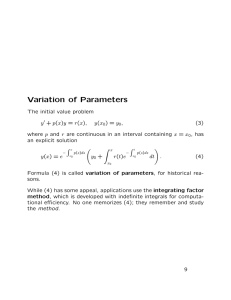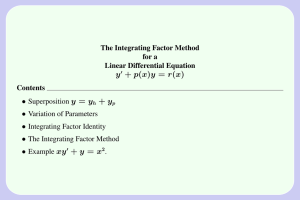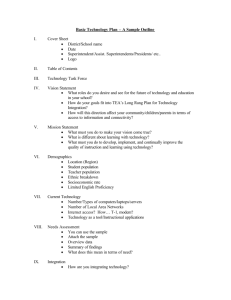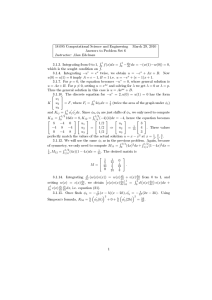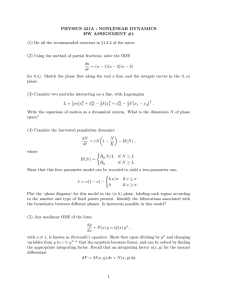2.3 Linear Equations
advertisement
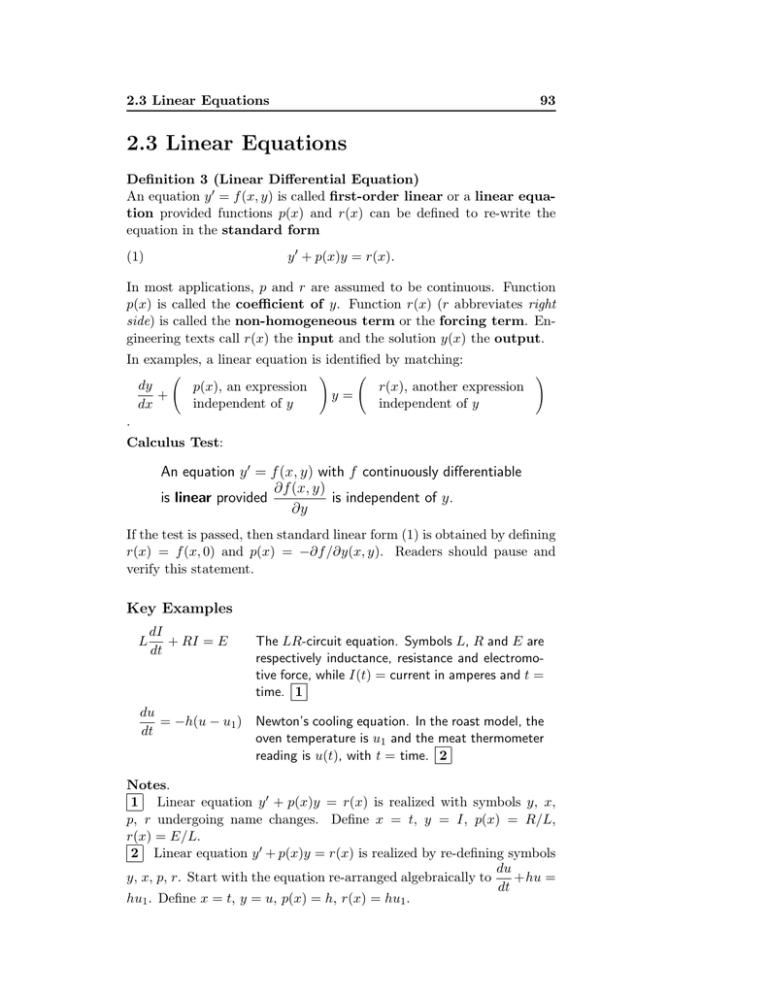
2.3 Linear Equations 93 2.3 Linear Equations Definition 3 (Linear Differential Equation) An equation y 0 = f (x, y) is called first-order linear or a linear equation provided functions p(x) and r(x) can be defined to re-write the equation in the standard form y 0 + p(x)y = r(x). (1) In most applications, p and r are assumed to be continuous. Function p(x) is called the coefficient of y. Function r(x) (r abbreviates right side) is called the non-homogeneous term or the forcing term. Engineering texts call r(x) the input and the solution y(x) the output. In examples, a linear equation is identified by matching: dy + dx p(x), an expression independent of y ! y= r(x), another expression independent of y ! . Calculus Test: An equation y 0 = f (x, y) with f continuously differentiable ∂f (x, y) is linear provided is independent of y. ∂y If the test is passed, then standard linear form (1) is obtained by defining r(x) = f (x, 0) and p(x) = −∂f /∂y(x, y). Readers should pause and verify this statement. Key Examples L dI + RI = E dt The LR-circuit equation. Symbols L, R and E are respectively inductance, resistance and electromotive force, while I(t) = current in amperes and t = time. 1 du = −h(u − u1 ) Newton’s cooling equation. In the roast model, the dt oven temperature is u1 and the meat thermometer reading is u(t), with t = time. 2 Notes. 1 Linear equation y 0 + p(x)y = r(x) is realized with symbols y, x, p, r undergoing name changes. Define x = t, y = I, p(x) = R/L, r(x) = E/L. 2 Linear equation y 0 + p(x)y = r(x) is realized by re-defining symbols du y, x, p, r. Start with the equation re-arranged algebraically to +hu = dt hu1 . Define x = t, y = u, p(x) = h, r(x) = hu1 . 94 Homogeneous Equation y 0 + p(x)y = 0 Homogeneous equations y 0 + p(x)y = 0 occur in applications devoid of external forces, like an LR-circuit with no battery in the circuit. Justified later is the fundamental result for such systems: The general solution of y(x) = dy + p(x)y = 0 is the fraction dx c constant = integrating factor W (x) where integrating factor W (x) is defined by the equation W (x) = e R p(x)dx . dI + 2I = 0 is the model dt R equation y 0 + p(x)y = 0 with p(x) = 2. Then W (x) = e 2dx = e2x , with integration constant set to zero. The general solution of y 0 + 2y = 0 is given by c c y= = 2x = ce−2x . W (x) e An Illustration. The LR-circuit equation The current is I(t) = c e−2t , by the variable swap x → t, y → I. Definition 4 (Integrating Factor) An integrating factor W (x) for equation y 0 + p(x)y = r(x) is W (x) = e R p(x)dx . Lemma 1 (Integrating Factor Identity) The integrating factor W (x) satisfies the differential equation W 0 (x) = p(x)W (x). Details. Write W = eu where u = p(x)dx. By the fundamental theorem of calculus, u0 = p(x) = the integrand. Then the chain rule implies w0 = u0 eu = u0 W = pW . R A Shortcut. Factor W (x) is generally expressed as a simplified expression, with integration constant set to zero and absolute value symbols removed. See the exercises for details about this simplification. For instance,R integration in the special case p(x) = 2 formally gives R p(x)dx R= 2dx = 2x + c1 . Then the integrating factor becomes W (x) = e 2dx = e2x+c1 = e2x ec1 . Fraction c/W (x) equals c2 /e2x , where c2 = c/ec1 . The lesson is that we could have chosen c1 = 0 to produce the same fraction. This is a shortcut, recognized as such, but we use it in examples to save effort. 2.3 Linear Equations 95 Non-Homogeneous Equation y 0 + p(x)y = r(x) Definition 5 (Homogeneous and Particular Solution) Let W (x) be an integratingR factor constructed for y 0 +p(x)y = r(x), that is, W (x) = eu , where u = p(x)dx is an antiderivative of p(x). Symbol yh , called the homogeneous solution, is defined by the expression c yh (x) = . W (x) Symbol yp , called a particular solution, is defined by the expression R yp (x) = r(x)W (x)dx W (x) Theorem 5 (Homogeneous and Particular Solutions) (a) Expression yh (x) is a solution of the homogeneous differential equation y 0 + p(x)y = 0. (b) Expression yp (x) is a solution of the non-homogeneous differential equation y 0 + p(x)y = r(x). Proof: (a) Define y = c/W . We prove y 0 + py = 0. Formula y = c/W implies (yW )0 = (c)0 = 0. The product rule and the Lemma imply (yW )0 = y 0 W + yW 0 = y 0 W + y(pW ) = (y 0 + py)W . Then (yW )0 = 0 implies y 0 + py = 0. The proof is complete. 0 (b) R We prove y + py = r when y is replaced by the fraction yp . Define C(x) = r(x)W (x)dx, so that y = C(x)/W (x). The fundamental theorem of calculus implies C 0 (x) = r(x)W (x). The product rule and the Lemma imply C 0 = (yW )0 = y 0 W + yW 0 = y 0 W + ypW = (y 0 + py)W . Competition between the two equations for C 0 gives rW = (y 0 + py)W ). Cancel W to obtain r = y 0 + py. The proof is complete. Historical Note. The formula for yp (x) has the historical name variation of constants or variation of parameters. Both yh and yp have the same form C/W , with C(x) constant for yh and C(x) equal to a function of x for yp : variation of constant c in yh produces the expression for yp . Experimental Viewpoint. The particular solution yp depends on the forcing term r(x), but the homogeneous solution yh does not. Experimentalists view the computation of yp as a single experiment in which the state yp is determined by the forcing term r(x) and zero initial data y = 0 at x = x0 . This particular experimental solution yp∗ is given by the definite integral formula (2) yp∗ (x) = 1 W (x) Z x r(x)W (x)dx. x0 96 Superposition. The sum of constant multiples of solutions to y 0 + p(x)y = 0 is again a solution. The next two theorems are superposition for y 0 + p(x)y = r(x). Theorem 6 (General Solution = Homogeneous + Particular) Assume p(x) and r(x) are continuous on a < x < b and a < x0 < b. Let y be a solution of y 0 + p(x)y = r(x) on a < x < b. Then y can be decomposed as y = yh + yp . In short, a linear equation has the solution structure homogeneous plus particular. R The constant c in formula yh and the integration constant in W (x)rx)dx can always be selected to satisfy initial condition y(x0 ) = y0 . Theorem 7 (Difference of Solutions = Homogeneous Solution) Assume p(x) and r(x) are continuous on a < x < b and a < x0 < b. Let y1 and y2 be two solutions of y 0 + p(x)y = r(x) on a < x < b. Then y = y1 − y2 is a solution of the homogeneous differential equation y 0 + p(x)y = 0. In short, any two solutions of the non-homogeneous equation differ by some solution yh of the homogeneous equation. Integrating Factor Method The technique called the method of integrating factors uses the replacement rule (justified on page 101) (3) Fraction R (Y W )0 replaces Y 0 + p(x)Y, where W = e W p(x)dx . The fraction (Y W )0 /W is called the integrating factor fraction. The Integrating Factor Method Standard Form Rewrite y 0 = f (x, y) in the form y 0 + p(x)y = r(x) where p, r are continuous. The method applies only in case this is possible. Find W Find a simplified formula for W = e p(x)dx . The anR tiderivative p(x)dx can be chosen conveniently. Prepare for Quadrature Obtain the new equation Method of Quadrature Clear fractions to obtain (yW )0 = RrW . Apply the method of quadrature to get yW = r(x)W (x)dx + C. Divide by W to isolate the explicit solution y(x). R (yW )0 = r by replacing the W 0 left side of y + p(x)y = r(x) by equivalence (3). 2.3 Linear Equations 97 In identity (3), functions p, Y and Y 0 are assumed continuous with p and Y arbitrary functions. Equation (3) is central to the method, because it collapses the two terms y 0 +py into a single term (W y)0 /W ; the method of quadrature applies to (W y)0 = rW . The literature calls the exponential factor W an integrating factor and equivalence (3) a factorization of Y 0 + p(x)Y . Simplifying an Integrating Factor Factor W is simplified by dropping constants of integration. To illustrate, R if p(x) = 1/x, then p(x)dx = ln |x| + C. The algebra rule eA+B = eA eB implies that W = eC eln |x| = |x|eC = (±eC )x, because |x| = (±)x. Let c1 = ±eC . Then W = c1 W1 where W1 = x. The fraction (W y)0 /W reduces to (W1 y)0 /W1 , because c1 cancels. In an application, we choose the simpler expression W1 . The illustration shows that exponentials in W can sometimes be eliminated. Variation of Constants and y 0 + p(x)y = r(x) Every solution of y 0 + p(x)y = r(x) can be expressed as y = yh + yp , by choosing constants appropriately. The classical variation of constants formula puts initial condition zero on yp and compresses all initial data into the constant c appearing in yh . The general solution is given by (4) y(x0 ) y(x) = + W (x) Rx x0 r(x)W (x)dx , W (x) Rx W (x) = e x0 p(s)ds Classifying Linear and Non-Linear Equations Definition 6 (Non-linear Differential Equation) An equation y 0 = f (x, y) that fails to be linear is called non-linear. Algebraic Complexity. A linear equation y 0 = f (x, y) may appear to be non-linear, e.g., y 0 = (sin2 (xy) + cos2 (xy))y simplifies to y 0 = y. Computer Algebra System. These systems classify an equation y 0 = f (x, y) as linear provided the identity f (x, y) = f (x, 0) + fy (x, 0)y is valid. Equivalently, f (x, y) = r(x) − p(x)y, where r(x) = f (x, 0) and p(x) = −fy (x, y). Hand verification can use the same method. To illustrate, consider y 0 = f (x, y) with f (x, y) = (x − y)(x + y) + y(y − 2x). Compute f (x, 0) = x2 , fy (x, 0) = −2x. Because fy is independent of y, then y 0 = f (x, y) is the linear equation y 0 + p(x)y = r(x) with p(x) = 2x, r(x) = x2 . Non-Linear Equation Tests. Elimination of an equation y 0 = f (x, y) from the class of linear equations can be done from necessary conditions. The equality fy (x, y) = fy (x, 0) implies two such conditions: 98 1. If fy (x, y) depends on y, then y 0 = f (x, y) is not linear. 2. If fyy (x, y) 6= 0, then y 0 = f (x, y) is not linear. For instance, either condition implies y 0 = 1 + y 2 is not linear. Special Linear Equations There are fast ways to solve certain linear differential equations that do not employ the linear integrating factor method. Theorem 8 (Solving a Homogeneous Equation) Assume p(x) is continuous on a < x < b. Then the solution of the homogeneous differential equation y 0 + p(x)y = 0 is given by the formula (5) y(x) = constant . integrating factor Theorem 9 (Solving a Constant-Coefficient Equation) Assume p(x) and r(x) are constants p, r with p 6= 0. Then the solution of the constant-coefficient differential equation y 0 + py = r is given by the formula constant + equilibrium solution integrating factor r = ce−px + . p y(x) = (6) Proof: The homogeneous solution is a constant divided by the integrating factor, by Theorem 8. An equilibrium solution can be found by formally setting y 0 = 0, then solving for y = r/p. By superposition Theorem 6, the solution y must be the sum of these two solutions. We remark that the case p = 0 results in a quadrature equation y 0 = r which is routinely solved by the method of quadrature. Examples 12 Example (Shortcut: Homogeneous Equation) Solve the homogeneous equation 2y 0 + x2 y = 0. Solution: By Theorem (8), the solution is a constant divided by the integrating factor. First, divide by 2 to get y 0 + p(x)y = 0 with p(x) = 12 x2 . Then R 3 p(x)dx = x3 /6 + c implies W = ex /6 is an integrating factor. The solution c is y = x3 /6 . e 13 Example (Shortcut: Constant-Coefficient Equation) Solve the non-homogeneous constant-coefficient equation 2y 0 − 5y = −1. 2.3 Linear Equations 99 Solution: The method described here only works for first order constantcoefficient differential equations. If y 0 = f (x, y) is not linear or it fails to have constant coefficients, then the method fails. The solution has two steps: (1) Find the solution yh of the homogeneous equation 2y 0 − 5y = 0. The answer is a constant divided by the integrating factor, which is c y = −5x/2 . First divide the equation by 2 to obtain the standard e R form y 0 + (−5/2)y = 0. Identify p(x) = −5/2, then p(x)dx = −5x/2 + c and finally W = e−5x/2 is the integrating factor. The answer is yh = c/W = ce5x/2 . (2) Find an equilibrium solution yp for 2y 0 − 5y = −1. This answer is found by formally replacing y 0 by zero. Then yp = 51 . The answer is the sum of the answers from (1) and (2), by superpositon, giving 1 y = yh + yp = ce5x/2 + . 5 The method of this example is called the superposition method shortcut. 14 Example (Integrating Factor Method) Solve 2y 0 + 6y = e−x . Solution: The solution is y = 1 −x 4e + ce−3x . An answer check appears in Example 16. The details: y 0 + 3y = 0.5e−x Divide by 2 to get the standard form. R Find the integrating factor W = e 3dx . 3x W =e 0 e3x y = 0.5e−x e3x 0 e3x y = 0.5e2x R e3x y = 0.5 e2x dx 2x Replace the LHS of y 0 + 3y = 0.5e−x by the integrating factor quotient; see page 96. Clear fractions. Prepared for quadrature Method of quadrature applied. y = 0.5 e /2 + c1 e = 41 e−x + ce−3x −3x Evaluate the integral. Divide by W = e3x . Final answer, c = 0.5c1 . 15 Example (Superposition) Find a particular solution of y 0 + 2y = 3ex with fewest terms. Solution: The answer is y = ex . The first step solves the equation using the integrating factor method, giving y = ex + ce−2x ; details below. A particular solution with fewest terms, y = ex , is found by setting c = 0. Integrating factor method details: y 0 + 2y = 3ex The standard form. W = e2x R Find the integrating factor W = e 2dx . 100 0 e2x y = 3ex e3x R e2x y = 3 e3x dx y = e3x + c e−2x = ex + ce−2x Integrating factor identity applied to y 0 + 2y = 3ex . Clear fractions and apply quadrature. Evaluate the integral. Isolate y. Solution found. Remarks on Integral Formula (2). Computer algebra systems will compute the solution yp∗ = ex − e3x0 e−2x of equation (2). It has an extra term because of the condition y = 0 at x = x0 . The shortest particular solution ex and the integral formula solution yp∗ differ by a homogeneous solution c1 e−2x , where c1 = e3x0 . To shorten yp∗ to yp = ex requires knowing the homogeneous solution, then apply superposition y = yp + yh to extract a particular solution. 16 Example (Answer Check) Show the answer check details for 2y 0 + 6y = e−x and candidate solution y = 41 e−x + ce−3x . Solution: Details: LHS = 2y 0 + 6y Left side of the equation 2y 0 + 6y = e−x . = 2(− 41 e−x − 3ce−3x ) + 6( 14 e−x + ce−3x ) =e −x +0 Substitute for y. Simplify terms. = RHS DE verified. 17 Example (Finding yh and yp ) Find the homogeneous solution yh and a particular solution yp for the equation 2xy 0 + y = 4x2 on x > 0. Solution: The solution by the integrating factor method is y = 0.8x2 + cx−1/2 ; details below. Then yh = cx−1/2 and yp = 0.8x2 give y = yh + yp . The symbol yp stands for any particular solution. It should be free of any arbitrary constants c. 5/2 Integral formula (2) gives a different particular solution yp∗ = 0.8x2 −0.8x0 x−1/2 . It differs from the shortest particular solution 0.8x2 by a homogeneous solution Kx−1/2 . Integrating factor method details: y 0 + 0.5y/x = 2x Standard form. Divided by 2x. p(x) = 0.5/x Identify R coefficient of y. Then p(x)dx = 0.5 ln |x| + c. W = e0.5 ln |x|+c The integrating factor is W = e W =e 0.5 ln |x| 1/2 = |x| 1/2 0 x y = 2x x1/2 R p . Choose integration constant zero. Used ln un = n ln u. Simplified W found. Integrating factor identity applied on the left. Assumed x > 0. 2.3 Linear Equations R x1/2 y = 2 x3/2 dx y = 4x5/2 /5 + c x−1/2 = 4 2 5x −1/2 + cx 101 Clear fractions. Apply quadrature. Evaluate the integral. Divide to isolate y. Solution found. 18 Example (Classification) Classify the equation y 0 = x + ln (xey ) as linear or non-linear. Solution: It’s linear, with standard linear form y 0 + (−1)y = x + ln x. To explain why, the term ln (xey ) on the right expands into ln x + ln ey , which in turn is ln x + y, using logarithm rules. Because ey > 0, then ln(xey ) makes sense for only x > 0. Henceforth, assume x > 0. Computer algebra test f (x, y) = f (x, 0) + fy (x, 0)y. Expected is LHS − RHS = 0 after simplification. This example produced ln ey − y instead of 0, evidence that limitations may exist. assume(x>0): f:=(x,y)->x+ln(x*exp(y)): LHS:=f(x,y): RHS:=f(x,0)+subs(y=0,diff(f(x,y),y))*y: simplify(LHS-RHS); If the test passes, then y 0 = f (x, y) becomes y 0 = f (x, 0) + fy (x, 0)y. This example gives y 0 = x + ln x + y, which converts to the standard linear form y 0 + (−1)y = x + ln x. Details and Proofs Justification of Factorization (3): It is assumed that Y (x) is a given but otherwise arbitrary differentiable function. Equation (3) will be justified in its fraction-free form Z 0 Y eP = (Y 0 + pY ) eP , P(x) = p(x)dx. (7) 0 LHS = Y eP The left side of equation (7). = Y 0 eP + eP 0 Y Apply the product rule (uv)0 = u0 v + uv 0 . = Y 0 eP + peP Y = (Y 0 + pY ) eP Use the chain rule (eu )0 = u0 eu and P0 = p. The common factor is eP . = RHS The right hand side of equation (7). Justification of Formula (4): Existence. Because the formula is y = yh + yp for particular values of c and the constant of integration, then y is a solution by superposition Theorem (6) and existence Theorem (5). 102 Uniqueness. It remains to show that the solution given by (4) is the only solution. Start by assuming Y is another, subtract them to obtain u = y − Y . Then u0 + pu = 0, u(x0 ) = 0. To show y ≡ Y , it suffices to show u ≡ 0. According to the integrating factor method, the equation u0 + pu = 0 is equivalent to (uW )0 = 0. Integrate (uW )0 = 0 from x0 to x, giving u(x)W (x) = u(x0 )W (x0 ). Since u(x0 ) = 0 and W (x) 6= 0, it follows that u(x) = 0 for all x. This completes the proof. Remarks on Picard’s Theorem. The Picard-Lindelöf theorem, page 67, implies existence-uniqueness, but only on a smaller interval, and furthermore it supplies no practical formula for the solution. Formula (4) is therefore an improvement over the results obtainable from the general theory. Exercises 2.3 Integrating Factor Method. Apply 19. y0 + 2y = e−x the integrating factor method, page 0 −x 96, to solve the given linear equation. 20. 2y + y = 2e See the examples starting on page 99 Superposition. Find a particular sofor details. lution with fewest terms. See Example 15, page 99. 1. y 0 + y = e−x 2. y 0 + y = e−2x 21. 3y 0 = x 3. 2y 0 + y = e−x 22. 3y 0 = 2x 4. 2y 0 + y = e−2x 23. y 0 + y = 1 5. 2y 0 + y = 1 6. 3y 0 + 2y = 2 7. 2xy 0 + y = x 8. 3xy 0 + y = 3x 9. y 0 + 2y = e2x 10. 2y 0 + y = 2ex/2 0 −2x 0 −4x 11. y + 2y = e 12. y + 4y = e 24. y 0 + 2y = 2 25. 2y 0 + y = 1 26. 3y 0 + 2y = 1 27. y 0 − y = ex 28. y 0 − y = xex 29. xy 0 + y = sin x (x > 0) 30. xy 0 + y = cos x (x > 0) 31. y 0 + y = x − x2 13. 2y 0 + y = e−x 14. 2y 0 + y = e−2x 32. y 0 + y = x + x2 General Solution. Find yh and a par- 15. 4y 0 + y = 1 ticular solution yp . Report the general solution y = yh + yp . See Example 17, page 100. 16. 4y 0 + 2y = 3 33. y 0 + y = 1 17. 2xy 0 + y = 2x 34. xy 0 + y = 2 18. 3xy 0 + y = 4x 35. y 0 + y = x 2.3 Linear Equations 103 51. y 0 − 5y = −1 0 36. xy + y = 2x 37. y 0 − y = x + 1 0 52. 3y 0 − 5y = −1 53. 2y 0 + xy = 0 38. xy − y = 2x − 1 39. 2xy 0 + y = 2x2 (x > 0) 40. xy 0 + y = 2x2 (x > 0) 54. 3y 0 − x2 y = 0 55. y 0 = 3x4 y 56. y 0 = (1 + x2 )y Classification. Classify as linear or non-linear. Use the test f (x, y) = 57. πy 0 − π 2 y = −e2 f (x, 0) + fy (x, 0)y and a computer al2 0 3 2 gebra system, when available, to check 58. e y + e y = π the answer. See Example 18, page 101. 59. xy 0 = (1 + x2 )y 41. y 0 = 1 + 2y 2 60. ex y 0 = (1 + e2x )y 0 3 42. y = 1 + 2y Proofs and Details. 43. yy 0 = (1 + x) ln ey 61. Prove directly without appeal to 2 44. yy 0 = (1 + x) (ln ey ) Theorem 6 that the difference of two solutions of y 0 + p(x)y = r(x) 45. y 0 sec2 y = 1 + tan2 y is a solution of the homogeneous 2 equation y 0 + p(x)y = 0. 0 2 46. y = cos (xy) + sin (xy) 47. y 0 (1 + y) = xy 48. y 0 = y(1 + y) 49. xy 0 = (x + 1)y − xeln y 50. 2xy 0 = (2x + 1)y − xye− ln y 62. Prove that yp∗ givenR by equation (2) and yp = W −1 r(x)W (x)dx given in the integrating factor method are related by yp = yp∗ +yh for some solution yh of the homogeneous equation. 63. The equation y 0 = r with r conShortcuts. Apply theorems for the stant can be solved by quadrature, homogeneous equation y 0 + p(x)y = 0 without pencil and paper. Find y. or for constant coefficient equations y 0 + py = r. Solutions should be done 64. The equation y 0 = r(x) with r(x) continuous can be solved by without paper or pencil, then write the quadrature. Find a formula for y. answer and check it.
